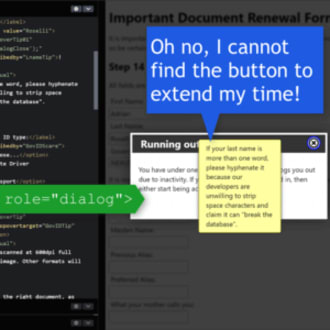a11y = Accessibility
TL;DR: a11y is shorthand for accessibility. Those middle characters are the number one, not lower-case Ls. Say it as A-one-one-Y or A-eleven-Y. Numeronym The a11y you may see on Twitter was not…
More from Adrian Roselli (no blue check) 🗯
Brief Note on Popovers with Dialogs
This is not a comparison between popovers and dialogs, nor is it a discussion of support. This is me trying to get ahead of a potential issue for users when developers mix and match the patterns. I…
Baseline Does Not Really Cover Baseline Support
Yeah, that’s not exactly a helpful title. The relatively new Web Platform Baseline offering does not track browser support for accessibility features built into the web platform. If you need to…
Be Careful Using ‘Menu’
TL;DR: Be careful when using the word menu. Be certain you have chosen the term that accurately describes the control you want. If this post looks familiar to you, that is because it is essentially a…
CSS-only Widgets Are Inaccessible
Usually. I originally titled this InacCSS-onlyible. I even made this typographically, er, distinct image. Then I realized it was silly and will instead use the neologism in a talk so I can hear the…
What is Refind?
Every day Refind picks the most relevant links from around the web for you. Picking only a handful of links means focusing on what’s relevant and useful. We favor timeless pieces—links with long shelf-lives, articles that are still relevant one month, one year, or even ten years from now. These lists of the best resources on any topic are the result of years of careful curation.
How does Refind curate?
It’s a mix of human and algorithmic curation, following a number of steps:
- We monitor 10k+ sources and 1k+ thought leaders on hundreds of topics—publications, blogs, news sites, newsletters, Substack, Medium, Twitter, etc.
- In addition, our users save links from around the web using our Save buttons and our extensions.
- Our algorithm processes 100k+ new links every day and uses external signals to find the most relevant ones, focusing on timeless pieces.
- Our community of active users gets the most relevant links every day, tailored to their interests. They provide feedback via implicit and explicit signals: open, read, listen, share, mark as read, read later, «More/less like this», etc.
- Our algorithm uses these internal signals to refine the selection.
- In addition, we have expert curators who manually curate niche topics.
The result: lists of the best and most useful articles on hundreds of topics.
How does Refind detect «timeless» pieces?
We focus on pieces with long shelf-lives—not news. We determine «timelessness» via a number of metrics, for example, the consumption pattern of links over time.
How many sources does Refind monitor?
We monitor 10k+ content sources on hundreds of topics—publications, blogs, news sites, newsletters, Substack, Medium, Twitter, etc.
Can I submit a link?
Indirectly, by using Refind and saving links from outside (e.g., via our extensions).
How can I report a problem?
When you’re logged-in, you can flag any link via the «More» (...) menu. You can also report problems via email to hello@refind.com
Who uses Refind?
450k+ smart people start their day with Refind. To learn something new. To get inspired. To move forward. Our apps have a 4.9/5 rating.
Is Refind free?
Yes, it’s free!
How can I sign up?
Head over to our homepage and sign up by email or with your Twitter or Google account.



